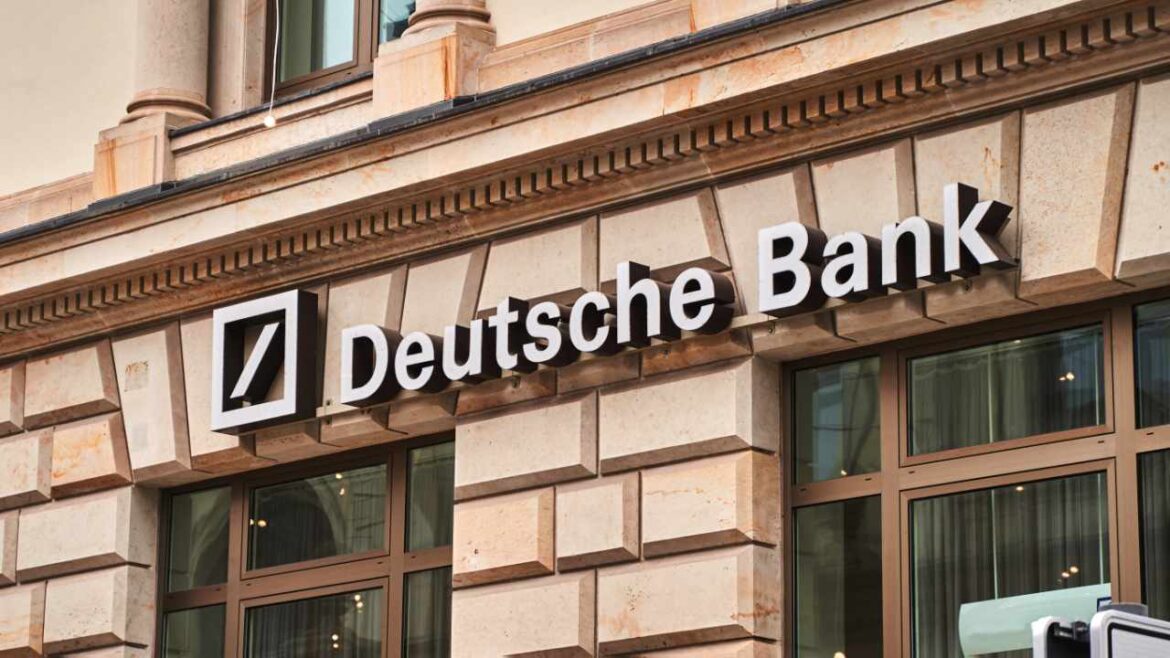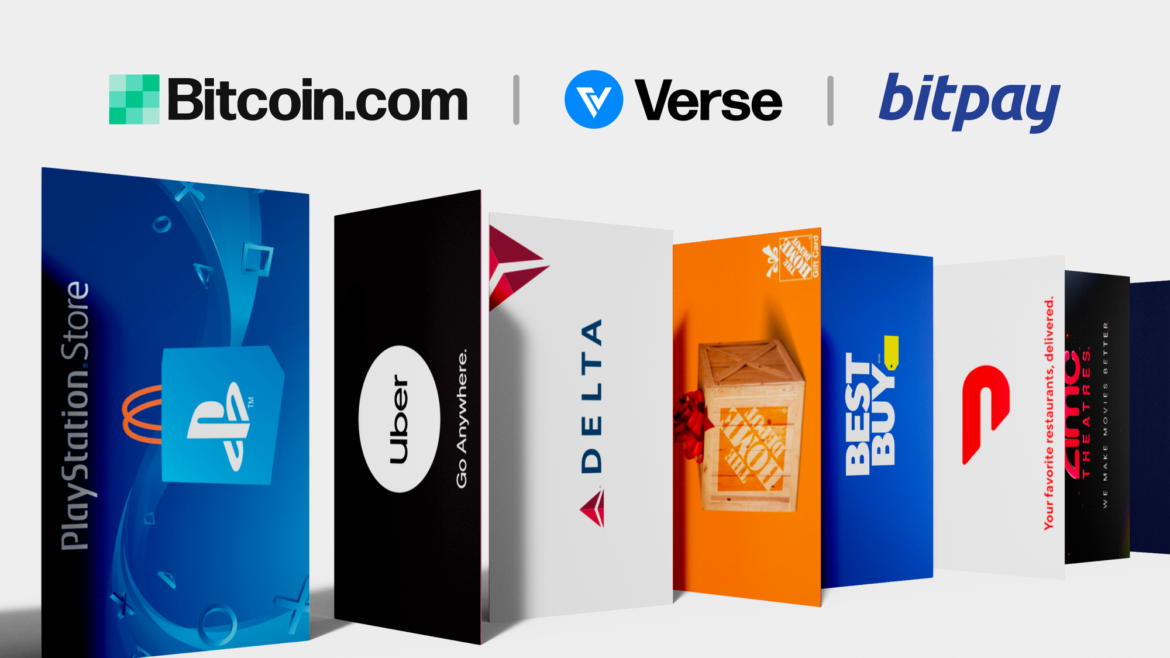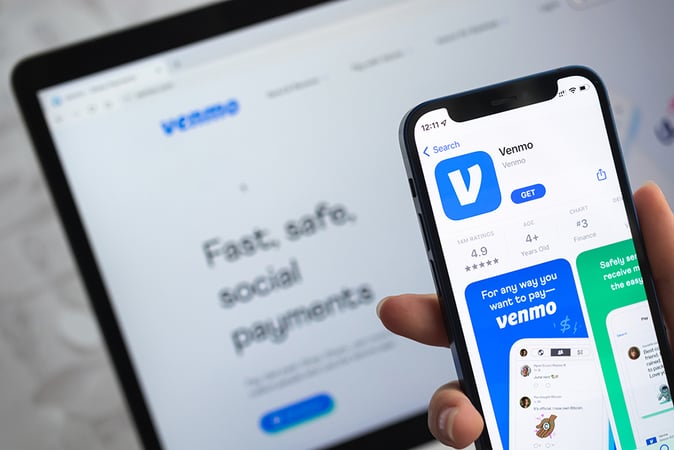 A new Deutsche Bank survey found that over half of respondents expect cryptocurrencies to become an important asset class and a method of payment. In addition, 10% of respondents expect the price of bitcoin to be above $75,000 by year-end. Deutsche Bank’s Crypto Survey A recent Deutsche Bank survey of over 3,600 consumers, published this […]
A new Deutsche Bank survey found that over half of respondents expect cryptocurrencies to become an important asset class and a method of payment. In addition, 10% of respondents expect the price of bitcoin to be above $75,000 by year-end. Deutsche Bank’s Crypto Survey A recent Deutsche Bank survey of over 3,600 consumers, published this […]
Source link
Payment
Telegram Implements Toncoin Payment Integration For Ads, TON Price Sees Impact
Telegram, the renowned messaging platform, recently unveiled a new feature that allows users to promote their channels through advertising. With the launch of this feature, users can now purchase ad space using Toncoins (TON), the native cryptocurrency powered by the TON blockchain.
Telegram Implements TON Blockchain For Ad Payments
Acknowledging the potential for channel owners to generate advertising revenue, Telegram’s announcement highlighted that channels collectively accumulate over 1 trillion views each month.
Realizing this opportunity, Telegram has implemented a revenue-sharing model, enabling channel owners with a minimum of 1000 subscribers to receive 50% of the ad revenue generated from ads displayed on their channels.
The decision to integrate the TON blockchain into this feature was driven by various reasons, as noted in the social media platform’s announcement on Sunday:
We chose the TON Blockchain because it has low fees, high transaction speeds – and holds a record for the number of transactions it can process per second. Anyone can now promote their bot or channel – with budgets as low as a handful of Toncoins. When creating a Telegram ad, you choose the exact channels where you’d like it to appear, so you have full control over their context.
Telegram CEO Pavel Durov had previously emphasized the importance of fast and secure ad payments and withdrawals, expressing that the TON blockchain would be the exclusive platform for these transactions. Durov stated:
To ensure ad payments and withdrawals are fast and secure, we will exclusively use the TON blockchain. Similar to our approach with Telegram usernames on Fragment, we will sell ads and share revenue with channel owners in Toncoin. This will create a virtuous circle, in which content creators will be able to either cash out their Toncoins — or reinvest them in promoting and upgrading their channels.
TON Shows Bullish Momentum
As Telegram unveils these new features and developments that can significantly boost the adoption and usage of the TON token, the cryptocurrency has responded positively.
Over the past 24 hours, TON has surged by more than 5%, reaching a current trading price of $5.30. This surge adds to its impressive 100% price increase over the past 30 days alone.
Notably, the announcement has also caused a substantial increase in the trading volume of TON, which has soared to $234,869,370 in the past 24 hours. This represents a rise of over 74% compared to Sunday’s trading volume, according to CoinGecko data.
Furthermore, the TON token is approaching its all-time high (ATH) mark of $5.69, reached on March 25. With the introduction of these new features in Telegram and the notable increase in trading volume, the token appears to be on the verge of setting a new ATH in the coming days if the demand continues to rise.
However, the token must surpass the significant resistance level of $5.45 for this scenario to unfold. This price level has proven to be a hurdle for the token, as it has attempted three times to break through and consolidate above it to reach a new ATH but has failed. Overcoming this resistance level is crucial before the token can approach new ATH levels.
On the TON/USD 4-hour chart, the support level that could potentially halt a price correction following the recent uptrend is $5.26. This support level acts as a buffer to prevent a significant downward correction in price.
Featured image from Shutterstock, chart from TradingView.com
Disclaimer: The article is provided for educational purposes only. It does not represent the opinions of NewsBTC on whether to buy, sell or hold any investments and naturally investing carries risks. You are advised to conduct your own research before making any investment decisions. Use information provided on this website entirely at your own risk.
Court rules in favor of Apple in class action over crypto payment policies

A California judge dismissed a class action lawsuit against Apple that accused the tech giant of imposing restrictions on third-party crypto payments on March 26.
District Judge Vince Chhabria said the complaint contained “several fatal problems,” including inadequately alleged agreements between Apple and other payment services.
He expressed doubts that the agreements restricted decentralized crypto transactions as alleged, asserting it is not clear that such an agreement would be unlawful under the Sherman Antitrust Act.
Meanwhile, the allegations of antitrust standing were found to be inadequate because any links between Apple’s alleged anticompetitive behavior and alleged injury were speculative. The plaintiffs claimed they paid overinflated fees to certain third-party apps because of Apple’s agreements.
Furthermore, the case had problems with its relevant market definition because Zelle — a payment app mentioned by the plaintiffs — was excluded from the definition.
The judge observed other issues and said an amendment to the case was unlikely to change the outcome of the lawsuit. However, the court has given plaintiffs 21 days to amend the case.
The case will be dismissed without prejudice if the plaintiffs fail to make amendments by the deadline.
Centralization vs. decentralization
Initially filed in November 2023, the lawsuit alleged that PayPal‘s Venmo, Google Pay, Cash App, and Apple Cash all agreed to Apple’s store guidelines, thereby agreeing to terms preventing each app from supporting decentralized crypto transactions.
Apple asked for the class action lawsuit to be dismissed in February. That request made most of the same points confirmed in the judge’s current dismissal.
Aside from their broader legal arguments, Apple’s defense asserted that the plaintiffs’ claims were factually incorrect, writing:
“There are apps in the App Store that facilitate decentralized [crypto] transactions.”
The defense added that a particular rule, App Store Guideline 3.1.5, requires third-party apps to handle transactions through an approved exchange and “does not apply to, much less categorically prohibit” apps that offer decentralized crypto transactions.
Plaintiffs initially argued that the same section undermines decentralization by requiring the involvement of intermediary exchanges.
Mentioned in this article
Bitcoin.com Announces Integration of VERSE Token With BitPay for Expanded Payment Options
 Bitcoin.com, a leading figure in the world of cryptocurrency and blockchain technology, is thrilled to announce a significant enhancement to the utility of its ecosystem token, VERSE. In a groundbreaking collaboration, VERSE has now been integrated with BitPay, the world’s largest provider of Bitcoin and cryptocurrency payment services. This integration heralds a new era of […]
Bitcoin.com, a leading figure in the world of cryptocurrency and blockchain technology, is thrilled to announce a significant enhancement to the utility of its ecosystem token, VERSE. In a groundbreaking collaboration, VERSE has now been integrated with BitPay, the world’s largest provider of Bitcoin and cryptocurrency payment services. This integration heralds a new era of […]
Source link
South Africa advances financial inclusion with crypto and digital payment reforms

South Africa announced plans to weave digital payments and crypto into its financial fabric to boost the economy for marginalized groups.
The announcement was made in the country’s 2024 budget and underlines the government’s drive to build a digital economy through active collaborations between public and private sectors to enhance financial innovation.
The budget targets enhancing access to digital payments for people in townships and rural areas who predominantly handle cash. Initiatives will provide local merchants with the infrastructure needed for digital transactions, like internet connectivity and point-of-sale systems.
Starting with a pilot in Gauteng, these efforts seek to broaden the acceptance and use of digital payments among both consumers and businesses.
Regulatory Standards
South Africa intends to legitimize crypto payments and make them an intrinsic part of the local economy over the coming years, starting with a regulatory framework for the sector. The country made crypto an official financial product in 2022, akin to company shares or debt.
The Intergovernmental Fintech Working Group (IFWG) will start issuing comprehensive guidelines in 2024 that will focus on “stablecoins” and their practical applications. This effort will complete a thorough review of the stablecoin environment domestically and create regulatory recommendations that align with global standards.
In 2023, the Financial Sector Conduct Authority (FSCA) and the Financial Intelligence Centre (FIC) started to register crypto asset service providers, following changes to the FIC Act that align with FATF recommendations. The FSCA’s classification of crypto as a financial product now requires service providers to obtain a license, ensuring they meet strict operational standards.
The government is reviewing the extension of the FIC Act’s mandate, which currently requires reporting cash transactions over R49,999, to include crypto transactions. The move aims to use such data in fighting crime.
Additionally, the government intends to explore tokenization and how blockchain technology can represent assets, with the publication of policy and regulatory implications planned for December 2024.
The South African central bank has been considering the development of a central bank digital currency (CBDC) for a number of years. However, the regulator has yet to announce any significant progress in the area.
Supporting financial inclusion
The National Treasury and the Reserve Bank, together with international partners, are rolling out four pilot projects focused on digital payments to aid small and informal businesses.
These projects aim to digitize community transactions, informal worker payments, and cross-border remittances to facilitate finance for small traders engaging in cross-border commerce. Each initiative addresses specific hurdles, from cutting remittance costs to implementing digital tipping for low-income workers.
These efforts highlight South Africa’s determination to be at the forefront of financial digitalization and inclusion, using technology to strengthen its economy and uplift its people. By integrating crypto and emphasizing a solid regulatory framework, the country shows a progressive approach that ensures innovation goes hand in hand with consumer protection and financial integrity.
My in-laws asked me to relinquish any claim to $100,000 they gave us as a down payment for our house — on the day we closed. Is that legal?
Dear Quentin,
My husband and I purchased a house together in New York about a year ago. We’ve been married 14 years. His parents gave us $100,000 toward the house, which was deposited in a joint bank account, one that I don’t have access to.
About a week later, my in-laws had me sign a document stating that the funds were considered “separate property” and that I wouldn’t claim any of those funds in case of a divorce. I signed this document on the day of the closing with their family lawyer, who was also the notary.
Does this document have legal standing in case of a divorce in New York state? Would this be considered signing under duress given that it happened on closing day, or a conflict of interest given that the family lawyer represented all of us?
Confused and Curious
Related: My Tinder match asked if I ‘rent or own’ my apartment. Is it gauche to ask financial questions before a first date?

“You have three questions to ask yourself: the legal and financial questions and the moral one.”
MarketWatch illustration
Dear Confused,
There is a lot of uncertainty in your letter about what happened on the day you signed this postnuptial agreement — and how you felt about signing it. The most revealing and yet confusing word you use is when you say your in-laws “had” you sign. It appears that you did so voluntarily and exercised your free will, but also that you felt pressure to do so. An attorney should walk you through the events of that day. But you do not say that you were forced to sign or did so under duress.
However, there are other aspects to this scenario that should be considered if you consult your own attorney — one who represents you exclusively. You say you were given no time to think it over. According to the New York City Bar: “If either you or your spouse uses pressure to get the postnuptial agreement signed or does not give the other enough time to consider the postnuptial agreement, the court may not enforce the postnuptial agreement.”
It adds: “The postnuptial agreement takes the control over your property and assets away from the state and places it in the hands of you and your spouse. A postnuptial is valid and can be enforced as long as it protects both you and your spouse and it was entered into with a full and fair disclosure of all assets by both you and your spouse. The agreement must also be executed and acknowledged with the full formality required for a property deed to be recorded.”
You say $100,000 was deposited into a joint account. I assume you mean it was one held by your in-laws and your husband, and your postnuptial agreement deals with this $100,000 as a separate gift before it was used as a down payment. (An aside: This strikes me as bizarre behavior, given that you are both buying a home — I assume you will both be on the deed as well as the mortgage — and you have been married for 14 years.)
Marital property versus separate property
“In order for an agreement waiving your right to marital property to be valid and enforceable under New York law — in this case the apparent postnuptial agreement at issue — it would have to be (i) in writing, (ii) subscribed by you and your husband and (iii) acknowledged or proven in the manner required to entitle a deed to be recorded,” says Ory Apelboim, partner in the Matrimonial & Family Law Practice Group at Blank Rome.
And if these conditions were met? “Then other issues might come into play,” he says. “New York has a strong public policy favoring individuals deciding their own interests through contracts. However, an agreement between spouses may be invalidated if the party challenging the agreement demonstrates that it was the product of fraud, duress or other inequitable conduct, or if the terms are unconscionable or the product of overreaching.”
The fact that you had no counsel and that it could be considered manifestly unfair could also play in your favor. “There could be an inference of overreaching by your husband, which he would be required to rebut,” Apelboim adds. “Additional considerations are the existence of a fiduciary relationship between you and your husband and the fact that postnuptial agreements are contracts which require consideration that is a benefit to each party.”
You have three questions to ask yourself: the legal and financial questions and the moral one. Do you have a legal basis to challenge the postnuptial agreement? Do you believe challenging your husband for half of this down payment ($50,000) would be worth it in the event you divorced? Or is this a matter of principle — you should have been given more time to consider your options, especially given that you have been married for 14 years?
If you do decide to contest this agreement, do it because you would not have signed under any other circumstances. How would you have responded if your in-laws had given you time to think this over? It seems like a big ask by your in-laws after 14 years of marriage. I could better understand their rationale if they had asked you to sign a prenuptial agreement. If you genuinely believe this is unfair, and you signed this contract under duress, ask an attorney for an opinion.
You can email The Moneyist with any financial and ethical questions at qfottrell@marketwatch.com, and follow Quentin Fottrell on X, the platform formerly known as Twitter.
Check out the Moneyist private Facebook group, where we look for answers to life’s thorniest money issues. Post your questions, tell me what you want to know more about, or weigh in on the latest Moneyist columns.
The Moneyist regrets he cannot reply to questions individually.
Previous columns by Quentin Fottrell:
I asked my elderly father to quitclaim his home so I can refinance it — and take out a $200,000 annuity for my sister and me. Is this a good idea?
My partner is against us getting married. I’m not on the deed to his home, but he has a revocable trust. What could go wrong?
I want my son to inherit my $1.2 million house. Should I leave it to my second husband in my will? He promised to pass it on.
A payment method that some call ‘phantom debt’ just hit a new record

New record-breaking numbers on buy-now-pay-later purchases show consumers aren’t getting spooked by the emerging payment method that some economists call “phantom debt.”
U.S. shoppers racked up $16.6 billion in buy-now-pay-later purchases during the holiday season, helping to close out a big year for the flexible payment option.
That’s according to Adobe Analytics, which pointed to a 14% increase in buy-now-pay-later purchasing over the holidays in a report released Thursday. Over the course of 2023, BNPL spending rose about 14% as well, to hit $75 billion.
The numbers are a bold-faced win for the emerging payment method. But some economists worry about the lack of clarity on the full size of the industry and the financial health of BNPL users.
BNPL services allow shoppers to split purchases into installments, and some options are interest-free. Consumers typically make payments over four to six weeks, but some plans allow for longer payment schedules. The payment method has surged in popularity, adopted first among younger and lower-income consumers, then expanding to a broader range of shoppers.
“I’m surprised that’s all the increase is,” Tim Quinlan, senior economist at Wells Fargo Economics, said of the 14% year-over-year rise in BNPL spending.
Quinlan and Shannon Seery Grein, an economist at Wells Fargo Economics, recently dubbed buy now pay later “the phantom debt.”
There’s no “definitive measure” yet on the full extent of BNPL use, Quinlan and Grein noted. Until that happens, “there is no way to know when this phantom debt could create substantial problems for the consumer and the broader economy,” they wrote.
For context, the dollar volume on loans from the industry’s biggest firms jumped to $24.2 billion in 2021 from $2 billion in 2019, according to the Consumer Financial Protection Bureau. That’s a 1,092% rise.
“I don’t think there’s anything inherently wrong with BNPL programs,” Quinlan told MarketWatch on Thursday. There are upsides, including greater purchasing power for consumers and more inclusion for people who may not have credit cards, good credit history or an established banking relationship.
But he worries about the potential for overspending if people get “lulled into a sense of complacency” by “small payments that add up to a big problem.” Another concern is the limited transparency in an industry with little regulation and monitoring, he said.
Given that context, it’s tough to say what the growing use of BNPL shows about consumer health right now, Quinlan noted.
Wall Street and policymakers, like the Federal Reserve, are focused on consumers’ financial well-being as they hold their breath for a “soft landing” that avoids recession after a bout of red-hot inflation and steep interest rate hikes. Americans have $1.08 trillion in credit card debt through the third quarter of 2023.
“In an uncertain demand environment, retailers leaned on discounting and flexible payment methods to entice shoppers this holiday season,” Adobe Digital Insights lead analyst Vivek Pandya said in a statement Thursday.
Growth in online holiday spending through BNPL methods outpaced growth in overall online spending during the period, with Adobe calculating a roughly 5% boost in general online spending from the start of November to the end of December. That amounted to $222 billion in spending.
Over half of that came from five categories: electronics, apparel, furniture, groceries and toys.
Investors seemed to notice the BNPL momentum in 2023, with Affirm Holdings Inc. shares
AFRM,
rallying more than 400% during the year. Admittedly, that rally followed a 90% plunge seen during 2022, and the stock is down to start 2024 as well.
“We underwrite every transaction individually and only approve consumers for what we believe they are willing and able to repay. Because we do not charge any late or hidden fees, our success is aligned with consumers successfully managing their finances,” an Affirm spokesperson.
The company says it advocates for BNPL inclusion in credit reporting so consumers can build their credit scores and lenders can have a full view of a person’s debts.
Regulators, like the Consumer Financial Protection Bureau, have also been watching BNPL’s momentum.
There are many BNPL users who tap the payment method “without any noticeable indications of financial stress,” CFPB researchers wrote last year in an analysis of consumer survey responses.
Still, compared to people who didn’t use BNPL methods, the report said BNPL users more often said they had debt, carried credit-card balances and used high-interest financial services like payday lenders.
Major credit reporting companies acknowledge there’s still a ways to go.
An Equifax
EFX,
spokesperson noted the credit reporting company started including buy now, pay later loan payment information in U.S. consumer credit reports starting in February 2022.
The BNPL reporting can help strengthen a consumer’s financial profile and serve as a “stepping stone to other types of credit.”
“Equifax is continuing to approach BNPL with an eye toward ensuring the inclusion of BNPL data on consumer credit files has a predictable impact on credit scores,” the spokesperson said. “BNPL is an emerging payment type in the U.S. and while there is an initial volume of BNPL loans, they are not being broadly reported at this time.”
Experian
EXPGY,
made a similar point.
“The practice of BNPL data reporting is currently limited; however, Experian is engaged with partners in the BNPL industry to make this data accessible to clients and consumers,” the company said in a statement, noting its long support to fold in data that builds consumers’ credit profiles.
Experian said its aim “is to drive transparency into the BNPL industry, resulting in improved support of consumers and risk management for lenders.”
Related: Is America’s record credit-card debt a red flag for the economy? ‘The trends are definitely not good.’
I Want to Give My Daughter and Her Husband $50,000 For a Down Payment. Do I Have to Worry About the Gift Tax?

Imagine you have $50,000 to give to your daughter and her husband for a down payment on their new home. The question is, will you owe gift taxes because of your generous gesture?
Despite popular framing, the federal gift and estate taxes only apply to very wealthy households. Unless you have approximately $13 million to give away over your lifetime, these taxes likely won’t apply to you.
A financial advisor can help you navigate and plan for gift and estate taxes. Find an advisor today.
To be very clear, these are the rules for federal taxation. Every state also has its own tax laws and every tax profile is different, so make sure to speak with a financial or tax professional before making any plans for your own assets. However, there are two main issues to consider within this scenario: the mortgage process and potential gift tax implications.
Down Payments and Gifts

With the mortgage and lender process, you want to ensure that you fill out all forms and requirements correctly. It is extremely unlikely that you can complicate the title to this property, but you can certainly complicate or invalidate the loan by making a mistake.
When your daughter applies for her mortgage, the lender will go through her finances in detail. They want to know what assets she has, where they came from, what income she has and any other information related to how she will repay this debt. The down payment is intended as an indicator of this financial stability, so receiving it from a third party can raise concerns.
Many lenders have rules around who can provide the money for a down payment. It’s common for them to reject a mortgage with a gifted down payment unless that money comes from someone with a longstanding relationship to the borrower. Among other issues, this is intended to prevent fraud and money laundering. Since the borrower is your daughter, that shouldn’t be a problem.
If you are giving the money directly to your daughter you will typically either need to “season” the money or provide a gift letter. Seasoning the money means transferring it more than 60 days in advance, again as an indicator of legitimacy against fraudulent transfers. A gift letter is a document signed by both the giver and the recipient confirming that this is a unilateral transfer with no right to repayment.
The specific format of the gift letter will vary based on lender and jurisdiction, so consult an attorney about this document. A financial advisor can also potentially help you through this process.
You may also make this transfer through the loan process, making the down payment on your daughter’s behalf rather than transferring the money to her. The lender will require you and your daughter to disclose this during the loan application process. In and of itself, your gift will typically not be a problem, but failing to specify the difference between borrower and payer will almost always complicate (if not invalidate) the loan.
Gift Tax Exclusions and Exemption Limits

Beyond the rules that surround making a gift of this sort, your main consideration here is the gift tax.
This is a tax that the IRS places on unilateral transfers. If you give someone money or assets without expecting fair-value compensation in return, you have given them a gift. If you give them enough money, eventually you (the gift giver) must pay taxes on the transfer. Gift tax rates range from 18% to 40% based on the size of the gift.
However, the gift tax only applies to very few households due to a pair of important tax provisions: an annual exclusion and a lifetime exemption limit. And if you have additional questions about either, consider speaking with a financial advisor.
Annual Exclusion
The first is the gift tax’s annual exclusion. This is the amount of money you can give to someone each year regardless of gifts in past or future years. In 2023, the annual exclusion is set at $17,000 for individuals and $34,000 for married couples who file their taxes jointly. In 2024, those limits will increase to $18,000 for individuals and $36,000 for married couples.
The annual exclusion applies on a per-recipient basis. So, for example, say that you had four children. You could give each of them $17,000 in 2023 without triggering any gift taxes.
Lifetime Exemption
The lifetime gift and estate tax exemption is the amount of money you can give away over the course of your life – or at your death – without triggering either gift or estate taxes. For gifts that exceed the annual exclusion, the difference is applied to your lifetime exemption. If you give someone a gift over that year’s annual exclusion and have exhausted your lifetime exemption, you’ll owe gift taxes on the amount of money that exceeds that year’s exclusion.
In 2023, the lifetime gift and estate tax exemption is $12.92 million for individuals, which means married couples have a combined exemption limit of $25.84 million. In 2024, the exemption will increase to $13.61 million for individuals and $27.22 million for married couples. If an individual has already gifted $12.92 million over the exclusion limits by 2023, they will be able to gift another $690,000 in 2024 (not including the annual exclusion amount).
Unlike the annual exclusion, the lifetime exemption does not reset. While you can gift up to the annual exclusion each year, any remainder permanently reduces your lifetime cap. The lifetime exemption is on a per-donor basis, meaning that it applies collectively to all gifts you have given. For example, say that in 2023 you give $20,000 to each of your four children. Each gift exceeds the exclusion by $3,000. Collectively, they would lower your lifetime gift and estate tax exemption by $12,000.
Gift Taxes And Down Payments
When it comes to your daughter’s down payment, the tax issues are this: Are you married? And how much have you given away throughout your life? Let’s assume you’re single for simplicity’s sake.
First, if you give her the down payment money in 2023, the first $17,000 of the gift will automatically be free of any potential tax liability. However, since the gift exceeds the annual exclusion by $33,000, that remainder will lower your lifetime exemption.
So, for example, if you have never given anyone a taxable gift, you will pay no gift tax and your annual exclusion will be reduced to $12.887 million ($12.92 million minus $33,000). If you have already exhausted your lifetime exemption, you would have to pay taxes on the $33,000.
However, there would still be ways to manage this potential tax liability. If you could wait until 2024 to give your daughter the money, your lifetime exemption would go up to $13.61 million. You can apply the remainder to the newly raised cap and will owe no taxes on the excess gift. But if you need additional help managing your tax liability, consider working with a financial advisor.
Bottom Line
Unless you have gifted more than $12.92 million over your lifetime, you can almost certainly give a $50,000 down payment to your daughter or other family member and not owe gift taxes in 2023. Just be careful to do the paperwork right, otherwise, it could complicate the loan.
Gift Tax Tips
-
Will the fact that this is your daughter complicate things? While the IRS does not treat gifts from parents differently, large gifts within a wealthy family can potentially complicate future planning around trusts and estates.
-
A financial advisor can help you strategically give away assets to lower your potential estate tax liability. Finding a financial advisor doesn’t have to be hard. SmartAsset’s free tool matches you with up to three vetted financial advisors who serve your area, and you can have a free introductory call with your advisor matches to decide which one you feel is right for you. If you’re ready to find an advisor who can help you achieve your financial goals, get started now.
Photo credit: ©iStock.com/gradyreese, ©iStock.com/payphoto, ©iStock.com/designer491
The post I Want to Give My Daughter and Her Husband $50,000 For a Down Payment. Do I Have to Worry About the Gift Tax? appeared first on SmartReads by SmartAsset.
Amazon Removes PayPal-backed Venmo as Payment Option, PYPL Stock Drops Nearly 2%
While Amazon did not provide the actual reason for not supporting Venmo as a payment option, the notable rise of web3 payment platforms could be a major factor.
In October last year, Amazon.com Inc (NASDAQ: AMZN) announced that it would begin to offer Venmo, a product of PayPal Holdings Inc (NASDAQ: PYPL), as a new payment option to boost its orders on the mobile app and Amazon.com site during the festival season. Initially, Amazon announced only its US-based customers would shop with the Venmo payment option. A year later, Amazon notified its users on Wednesday that it had dropped Venmo as a payment option, and the company will no longer let users pay using the PayPal-backed payment method beginning January 10, 2024. Following the announcement, PYPL stock closed Thursday trading at $58.48, down 1.76 percent from the day’s opening value.
Notably, PayPal has been bleeding for the past two years, whereby its stock has dropped approximately 18 percent year-to-date. As of this report, PaPal had a total market valuation of about $64.18 billion. Meanwhile, Amazon did not provide a specific reason for shutting Venmo out of its business, thus leading to speculation of possible differences in internal policies and the changing landscape. Moreover, an Amazon spokesperson highlighted that there are a dozen more payment options for shoppers on their platform.
“Due to recent changes, Venmo can no longer be added as a payment method. Venmo will remain available to users who currently have it enabled in their Amazon wallet until 01/10/24,” Venmo noted.
Amazon has continued to perform well since the Covid lockdown boom, whereby its stock market has risen about 74 percent YTD to a total valuation of around $1.49 trillion.
PayPal Forced Out of Business by Web3 Industry
For many years since its inception, PayPal has dominated global cross-border payments with its ruthless policies. PayPal and its payment products have been tormenting users with high fees and slow processing speed, whereby a single payment can take up to 180 days to be processed. As a result, more users have left the platform for other better alternatives, which include web3 payment platforms. Moreover, PayPal has been attempting to pivot toward blockchain technology through its latest stablecoins launch dubbed PayPal USD (PYUSD). Additionally, the company is in the process of conducting a $6 billion stock buyback to shield it from increased sell pressure.
The rise of web3 payments around the world has significantly threatened traditional businesses that are not ready to morph with the new technology. Moreover, blockchain technology offers a secure, near-instant, and cheap means to transfer funds around the world without any reliance on third parties.
Companies like Ripple Labs, Stellar Organization, and Coinbase Global Inc (NASDAQ: COIN) are on the cusp of dominating global cross-border payments amid the mainstream adoption of digital assets.
next
Blockchain News, Business News, Cryptocurrency News, Market News, News
You have successfully joined our subscriber list.

The city of Lugano, the economic capital of Italian-speaking southern Switzerland, will integrate the Polygon proof-of-stake (PoS) protocol into its crypto-friendly payment app, MyLugano.
According to the announcement on Polygon Labs’ website from Nov. 22, the updated version of MyLugano features a multichain digital wallet for personal custody. The press release mentions “several tokens” already integrated into this app section and the plans to add more.
The network provider for tens of thousands of decentralized applications with $5 billion in secured assets, Polygon has been a partner of the Swiss city since at least 2022. At the time, it became an infrastructure partner for the city’s stablecoin, LVGA.
According to the statement, MyLugano is also launching a new nonfungible token collection dedicated to the work of artist Yuri Catania. This is an NFT version of a 40-meter-long, 8-meter-high work on the wall of the Palazzo dei Congressi. The art piece will be tokenized on the Polygon network.
Related: Polygon gas fees spike 1,000% amid Ordinals-inspired token craze
Lugano is one of the world’s leaders in crypto adoption. The MyLugano app, built in collaboration with stablecoin issuer Tether, serves 30,000 users, or almost half of the city population, helping them to pay local small and medium-sized traders in digital currencies.
In March 2022, Lugano established a Center of Excellence for Blockchain Adoption in partnership with Tether to “become a major European blockchain hub.” The city administration plans to enable citizens and companies to pay cryptocurrency taxes soon. The ultimate goal is to accept crypto for payment of all goods and services, similar to fiat currency.
Despite its best efforts, Lugano won’t be the first Swiss city to allow for paying taxes in crypto, with the canton of Zug and the city of Zermatt already enabling it.
Magazine: This is your brain on crypto. Substance abuse grows among crypto traders










